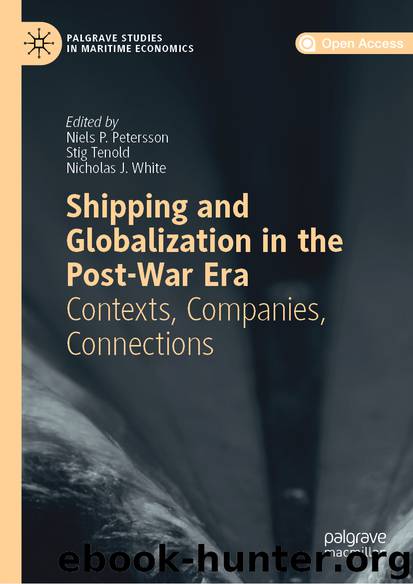Shipping and Globalization in the Post-War Era by Niels P. Petersson & Stig Tenold & Nicholas J. White

Author:Niels P. Petersson & Stig Tenold & Nicholas J. White
Language: eng
Format: epub
ISBN: 9783030260026
Publisher: Springer International Publishing
The Liner Replacement Vessels: A Fatal Investment
On 2 October 1974, EAC’s Board of Directors decided to promote Henning Sparsø to deputy CEO. Sparsø led the EAC’s ship department and reported directly to Pagh, occupying what was traditionally the second most prestigious position in the Company. It was always the ships’ results which were presented first at board meetings, and the department’s development was placed at the beginning of the annual reports ever since the founding of the company in 1897. It was from a strong position that Sparsø on 24 September 1975 presented the Board of Directors with perhaps the most fatal initiative in the history of the EAC—an initiative which, according to insightful observers, would eventually destroy the entire company.19
The EAC board meeting on 24 September 1975 began at 9.30 AM with a review of the positive results of three shipping alliances: ScanDutch on the Southeast Asia route, Johnson ScanStar on the American West Coast and ScanAustral on the Australia route. After about two hours of a general review of the company’s development, Sparsø was asked to round off the meeting with a review of EAC’s shipbuilding programme.20 Sparsø initially stated that the ship department had conducted in-depth analysis for a whole year in order to determine EAC’s need for new ships. The conclusion was that the Company should contract a whole new type of ship to be called ‘neo-bulk’. A relatively small and flexible ship—neither a traditional bulk carrier nor a container ship—of about 20,000 tonnes dwt, as against Selandia and Jutlandia’s 34,730 dwt. In fact, these ships went in the opposite direction to that taken with the recent container ship orders. Their service speed would be a modest 15.5 knots, and the energy-saving engine would only provide 11,600 hp against the two fast containerships’ record-breaking performance of 82,000 hp. It was an ambitious plan of a series of eight modern ships. Such a series had not been contracted since the much smaller—and significantly cheaper—conventional liner ships of the 1950s and 1960s. Pagh presented an interesting argument for the contracting of the new vessels. Where ship orders so far had reflected EAC’s specific strategic needs, what was sought now was ‘the most commercially useful and economical ship that would be a good asset for future sale’. The ship was to be regarded as a financial asset.
The success of the new ship type was crucial for EAC, as it should, in Sparsø’s cryptic words, ‘fill the need beyond what conventional bulk carriers can accommodate and, on the other hand, make the modern container ships’ facilities redundant’.21 What kind of cargo Sparsø specifically had in mind was not clear at the meeting, but the philosophy behind the new ship was flexibility. The ship should be able to transport containers, specialized cargo and traditional dry cargo such as timber or grain. However, the price for flexibility was the loss of economies of scale, and at the same time the small engines and low top speed prevented another type of flexibility namely the capability to catch up in case of delays.
Download
This site does not store any files on its server. We only index and link to content provided by other sites. Please contact the content providers to delete copyright contents if any and email us, we'll remove relevant links or contents immediately.
Hit Refresh by Satya Nadella(8996)
The Compound Effect by Darren Hardy(8735)
Change Your Questions, Change Your Life by Marilee Adams(7567)
Nudge - Improving Decisions about Health, Wealth, and Happiness by Thaler Sunstein(7461)
The Black Swan by Nassim Nicholas Taleb(6948)
Deep Work by Cal Newport(6820)
Daring Greatly by Brene Brown(6369)
Rich Dad Poor Dad by Robert T. Kiyosaki(6319)
Principles: Life and Work by Ray Dalio(6132)
Man-made Catastrophes and Risk Information Concealment by Dmitry Chernov & Didier Sornette(5878)
Playing to Win_ How Strategy Really Works by A.G. Lafley & Roger L. Martin(5775)
Digital Minimalism by Cal Newport;(5588)
Big Magic: Creative Living Beyond Fear by Elizabeth Gilbert(5557)
The Myth of the Strong Leader by Archie Brown(5375)
The Slight Edge by Jeff Olson(5316)
Discipline Equals Freedom by Jocko Willink(5241)
The Motivation Myth by Jeff Haden(5125)
Stone's Rules by Roger Stone(4989)
The Laws of Human Nature by Robert Greene(4926)
